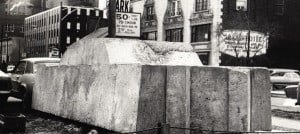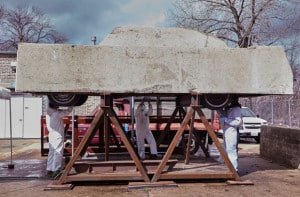This may not be relevant to building with concrete, but it is about an art piece made of concrete. It had to be built, in a way. German artist, Wolf Vostell, decided to build a concrete car around a 1957 Cadillac de Ville and parked it in the River North area of Chicago, right on the street. He died in 1998, and the concrete-surrounded car began to show signs of wear long before that. It ended up in a storage facility sometime between 1970 and 2016. Cue 2016, and Christine Mehring, Professor and Chair of the University of Chicago Department of Art History. She happened to find out about the concrete car, not having been there in 1970, and was amazed that it was left to fall apart on its own. It is now parked in the Campus North Parking Garage entrance at the university in Hyde Park.Dr. Mehring received a $125,000 grant to have the piece restored, all 16 tons of it. Imagine the trauma of moving it from its storage site to the university parking garage. It was loaded onto a truck, with a crane, and driven there without any significant damage. This has to be a testimony to the strength and durability of concrete.
Cue 2016, and Christine Mehring, Professor and Chair of the University of Chicago Department of Art History. She happened to find out about the concrete car, not having been there in 1970, and was amazed that it was left to fall apart on its own. It is now parked in the Campus North Parking Garage entrance at the university in Hyde Park.Dr. Mehring received a $125,000 grant to have the piece restored, all 16 tons of it. Imagine the trauma of moving it from its storage site to the university parking garage. It was loaded onto a truck, with a crane, and driven there without any significant damage. This has to be a testimony to the strength and durability of concrete. 
Concrete Art
The moving of the car was an event in itself, called “Concrete Happenings,” and took place in September, 2016. The event was also part of a year-long celebration of public art in Chicago which goes on in 2017. The name of the concrete car art piece is “Concrete Traffic.” It can be seen in the parking garage any time, for free, and given its weight, it will probably be there for some time.
There are other concrete art pieces, but this newly found work and its celebration is something that many can relate to: concrete and cars. At the initial exhibition, visitors were leaning against it, and kids were walking on top of it, so it is a public-friendly art installation. It might not be quite as accessible after restoration, but then again, it may be. The city of Chicago has a goal of placing art pieces in as many neighborhoods as possible, accessible to the public, for free, during its year-long celebration. It does seem appropriate that one is a concrete car with the miles and miles of highway in and around Chicago.
Back in the 1930s, another German artist, Theo van Doesburg, was responsible for coining the phrase, “concrete art,” and formed a group and a manifesto to promote it, defend it, or do whatever his goal was. The Germans do use a lot of concrete, so maybe Theo looked around and was struck by an inspiration. There is a huge, 66-ton Max Bill piece of abstract concrete art in Frankfurt, Germany that boggles the mind. It is symmetrical and perfect-looking, and somehow looks like a solid, curled-around triangle. Well, it would be better to look it up than try to make sense of that last sentence.
Smaller pieces of concrete art would be financially reasonable because many are made from casts and sold in garden stores. They enhance outdoor spaces, but some are made for indoor areas as well. You can put concrete art anywhere you want, anyway. It looks great around a patio and pool space, and some pieces can be set in their own place in the grass, sitting on a stone base of gravel or limestone. Even better, a decorative cement base would support and highlight a concrete art piece. There are so many possibilities.
Family themes, pets and hobby ideas might be turned into decorative cement bases to hold similar art, or just to be viewed as they are. Create a decorative cement place on the ground, in the yard, and put a couple of benches or chairs around it, and voila, automatic interest. Let the ideas spin around for a while and find the project that will become a conversation piece in your home and on the lawn. It should be something you enjoy looking at on a daily basis. Those of us not fortunate enough to have water views must come up with something else of interest. Concrete art might be it.




